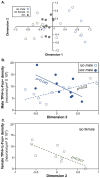Solitude and serotonin: juvenile isolation alters the covariation between social behavior and cFos expression by serotonergic neurons
- PMID: 39502712
- PMCID: PMC11535725
- DOI: 10.3389/fnins.2024.1446866
Solitude and serotonin: juvenile isolation alters the covariation between social behavior and cFos expression by serotonergic neurons
Abstract
Variation in the mutual responsiveness of social partners to each other can be reflected in behavioral suites that covary with neural activity in ways that track the salience or valence of interactions. Juvenile social isolation alters social behavior and neural activity during social interaction, but whether and how it alters the covariation between behavior and neural activity has not been as well explored. To address this issue, four classes of experimental subjects: isolated males, socially housed males, isolated females, and socially housed females, were paired with an opposite-sex social partner that had been socially housed. Social behaviors and c-Fos expression in the serotonergic dorsal raphe nucleus (DRN) were then measured in subjects following the social interactions. Relative to social housing, postweaning isolation led to a decrease in the density of neurons double-labeled for tryptophan hydroxylase and c-Fos in the dorsomedial subdivision of the DRN, regardless of sex. Vocal and non-vocal behaviors were also affected by isolation. In interactions with isolated males, both ultrasonic vocalization (USVs) and broadband vocalizations (squeaks) increased in conjunction with greater male investigation of females. Neural and behavioral measures also correlated with each other. In the isolated male group, the density of double-labeled neurons in the dorsomedial DRN was negatively correlated with USV production and positively correlated with a principal component of non-vocal behavior corresponding to greater defensive kicking by females and less investigation and mounting behavior. This correlation was reversed in direction for socially housed males, and for isolated males versus isolated females. These findings confirm that the dynamics of social interactions are reflected in c-Fos activation in the dorsomedial DRN, and suggest an altered responsiveness of serotonergic neurons to social interaction following social isolation in males, in parallel with an altered male response to female cues.
Keywords: dorsal raphe nucleus; opposite sex interaction; postweaning; serotonin; social competence; social isolation; social plasticity; ultrasonic vocalization.
Copyright © 2024 Hutchens, Khurram and Hurley.
Conflict of interest statement
The authors declare that the research was conducted in the absence of any commercial or financial relationships that could be construed as a potential conflict of interest.
Figures







Similar articles
-
Short-term social isolation acts on hypothalamic neurons to promote social behavior in a sex- and context-dependent manner.Elife. 2025 Mar 4;13:RP94924. doi: 10.7554/eLife.94924. Elife. 2025. PMID: 40035330 Free PMC article.
-
Postweaning Isolation Alters the Responses of Auditory Neurons to Serotonergic Modulation.Integr Comp Biol. 2021 Jul 23;61(1):302-315. doi: 10.1093/icb/icab051. Integr Comp Biol. 2021. PMID: 33974061
-
Early-Life Social Isolation Influences Mouse Ultrasonic Vocalizations during Male-Male Social Encounters.PLoS One. 2017 Jan 5;12(1):e0169705. doi: 10.1371/journal.pone.0169705. eCollection 2017. PLoS One. 2017. PMID: 28056078 Free PMC article.
-
Social experience alters socially induced serotonergic fluctuations in the inferior colliculus.J Neurophysiol. 2017 Dec 1;118(6):3230-3241. doi: 10.1152/jn.00431.2017. Epub 2017 Aug 30. J Neurophysiol. 2017. PMID: 28855293
-
GABAergic modulation of serotonergic neurons in the dorsal raphe nucleus.Rev Neurosci. 2019 Apr 24;30(3):289-303. doi: 10.1515/revneuro-2018-0014. Rev Neurosci. 2019. PMID: 30173207 Review.
References
-
- Ago Y., Araki R., Tanaka T., Sasaga A., Nishiyama S., Takuma K., et al. . (2013). Role of social encounter-induced activation of prefrontal serotonergic systems in the abnormal behaviors of isolation-reared mice. Neuropsychopharmacology 38, 1535–1547. doi: 10.1038/npp.2013.52, PMID: - DOI - PMC - PubMed
-
- Alger S. J., Kelm-Nelson C. A., Stevenson S. A., Juang C., Gammie S. C., Riters L. V. (2020). Complex patterns of dopamine-related gene expression in the ventral tegmental area of male zebra finches relate to dyadic interactions with long-term female partners. Genes Brain Behav. 19:e12619. doi: 10.1111/gbb.12619, PMID: - DOI - PMC - PubMed
LinkOut - more resources
Full Text Sources

